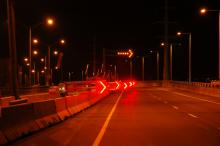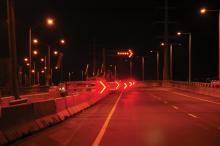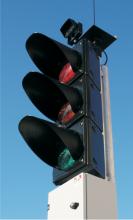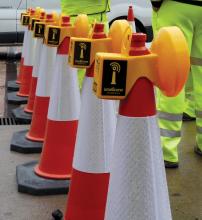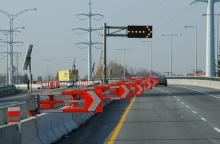Everyone connected with the highway industry is involved in the efforts to cut down the number of work zone accidents. Patrick Smith reports. A few months ago, as road work resumed on America's highways and bridges, US Transportation Secretary Ray LaHood called on drivers to use extra caution in work zones. At the same time he commended the success in reducing overall roadway fatalities in each of the last seven years.
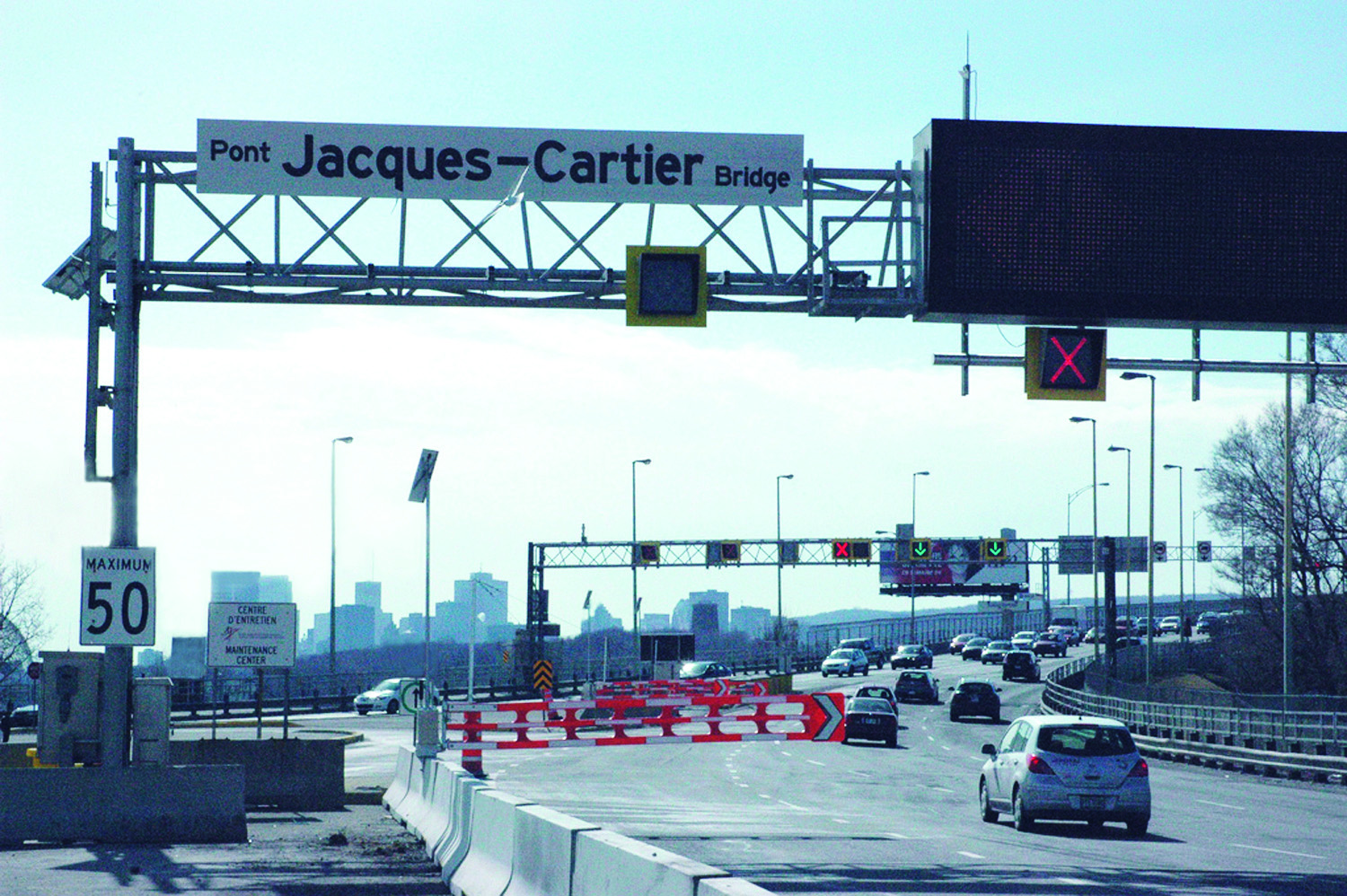
Versilis’ SwiftGate automated lane closure system on the Jacques Cartier Bridge
Everyone connected with the highway industry is involved in the efforts to cut down the number of work zone accidents. Patrick Smith reports
A few months ago, as road work resumed on America's highways and bridges, US Transportation Secretary Ray LaHood called on drivers to use extra caution in work zones. At the same time he commended the success in reducing overall roadway fatalities in each of the last seven years.According to newly-reported
In 2009, the most recent year for which data are available, highway work zone fatalities fell to the lowest level since 1992, despite the presence of thousands of new highway projects made possible by the American Recovery and Reinvestment Act. Work zone fatalities fell each year between 2002 and 2009 and dropped by more than 7% from 720 in 2008 to 667 in 2009. Overall work zone fatalities and injuries have fallen by 35% since 2000.
However, while such figures are still too high, high-profile initiatives in the US, including its National Work Zone Awareness Week, have played major parts in the reduction.
The annual campaign, to encourage safe driving through highway construction sites, is observed across the country by transportation officials in April, the start of the construction season.
Indeed, The American Road & Transportation Builders Association's Transportation Development Foundation (ARTBA-TDF) honoured a number of public and private organisations for their commitment to road construction zone safety at the 13th annual Roadway Work Zone Safety Awareness Awards. The competition recognises outstanding programmes that are aimed at helping reduce roadway work zone accidents, injuries and fatalities.
For example, the UK has one of the busiest high speed road networks in the world. Due to recent fatalities of its road workers, the
A key action from the agency's Road Worker Safety Strategy - Aiming for Zero, is the use of speed detection and enforcement techniques as a key lever to manage the speed of vehicles through roadworks to facilitate reduced speed limits for overnight and short-term road works.
In Riyadh, the Saudi Arabian capital, the use of Vitronic's PoliScanspeed laser-based system for speed enforcement is said to have resulted in a drop of 38% in the number of traffic fatalities in just four months in 2010, while the number of accidents declined by 21%.
The German company says that the LIDAR technology used in PoliScanspeed allows for simultaneous surveillance and enforcement of virtually any number of vehicles in multiple lanes, and it is also possible to take an image of the vehicle at a moment ideal for the image to document the violation. This is made possible by a high-resolution laser that captures the current positions of individual vehicles at all times without precision being influenced by guardrails.
"Thus, a measurement data set is created from the position of each vehicle, comprising the road and the speed travelled at any specific time within the tracking zone. It allows a clear allocation between the captured vehicle and its speed. Even if multiple speeders are travelling at close proximity to one another, PoliScanspeed captures them all. Up to four speeders can be documented within one second," says the company, which highlights the importance of the selection of enforcement locations.
"PoliScanspeed makes it possible to measure in bends, road work areas or anywhere where many vehicles park or stop briefly in places that are particularly dangerous." Two products from
Over 35.8 million vehicles cross the bridge every year, and its lanes include a reversible centre lane that is only open during morning and evening rush-hours, alternating directions (northbound or southbound) according to the flow of traffic.
However, motorists on the southern approach often waited until the last moment to merge right as their lane narrowed when the centre lane ahead was closed to northbound traffic. These rapid lanes changes presented risks that the Jacques Cartier and Champlain Bridges Incorporated (JCCBI) wanted to eliminate.
After consultation with experts in the field, JCCBI decided to install the SwiftGate automated lane closure systems and SwiftSign dynamic signage systems from Versilis to help improve the safety of lane changes on the southern approach.
SwiftGate and SwiftSign are remotely activated systems that consist of a set of modules controlled by an RF remote control. Each system module consists of a pivoting gate or sign, a solar panel, a control box and a remote control. The system runs entirely on solar energy, speeding installing or relocating of the modules.
When activated, the gates or signs pivot into position facing traffic quickly and safely so crews do not have to work in live traffic setting barrels or cones. Lane closure can be accomplished in as little as four minutes. "SwiftGates and SwiftSigns have proven to be a safer and more efficient alternative to hazardous, time-consuming and costly lane closure operations," says Versilis, a sister company of QMB Barrier, a moveable barrier service company and distributor of road safety products.A project for the north approach is currently being studied by JCCBI in collaboration with the City of Montreal.
FG 300 Model UR posts are highly visible, day and night, and clearly delineate driving lanes using bright colours and reflective sheeting, and have been developed to meet the rigorous demands of high-speed, two-way, two-lane operations. "The post greatly improves safety by reducing the time workers have to spend in the roadway maintaining channelising devices," says Davidson, a division of Pexco.
A clover-leaf design is said to provide inherent rebound; it offers impact resistance at any temperature, and is available in nine colours.
"FG 300 posts have successfully completed an extensive testing and certification process so they may be used on the roadways of North America.
Davidson highlights the product's "excellent results on the US National Test Deck," and its use for high-speed HOT lanes carrying 1.3 million vehicles a year to improving traffic flow through dangerous work zones.
The latest high-output LED technology, developed and produced by Berghaus, is now being fitted in the ultra-flat LED advance warning lights for a wide range of different applications including work zones.
According to Berghaus, which has had the units tested at the German Federal Highway Research Institute (BASt), compared to its halogen technology, the new solution takes up far less current and achieves a far longer operating period with just one battery charge.

